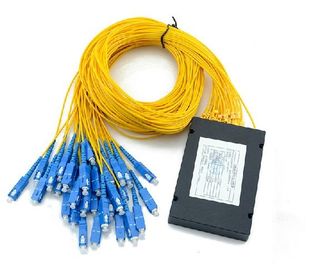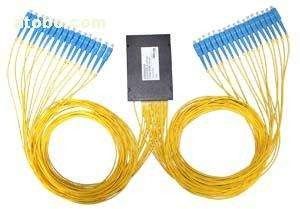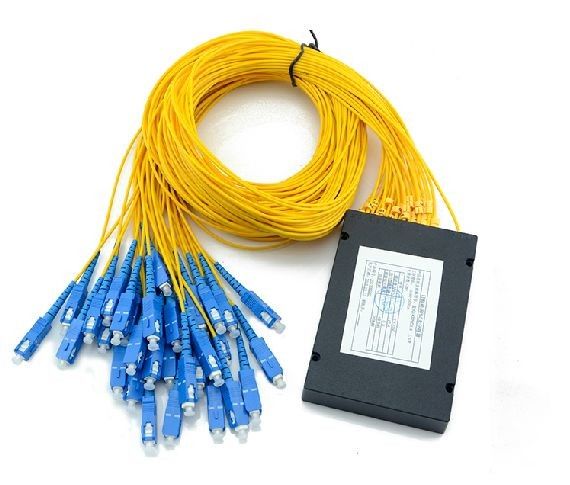Planar Lightwave Circuit (PLC) Fiber Optic Splitter ABS 1*16 For Network
Product Details:
| Place of Origin: | China |
| Brand Name: | TTI Fiber |
| Certification: | ISO 9001, ISO 14001, REACH, ROHS, CE and CPR certificates |
| Model Number: | PLC |
Payment & Shipping Terms:
| Minimum Order Quantity: | 1000 |
|---|---|
| Price: | Negotiable |
| Packaging Details: | Boxes |
| Delivery Time: | 2- 3 Days |
| Payment Terms: | L/C, T/T, D/A, D/P, , ,Paypal |
| Supply Ability: | 1000 Pieces / Day |
|
Detail Information |
|||
| Name: | PLC Fiber Splitter | Material: | ABS |
|---|---|---|---|
| Application: | FTTH | Wavelength: | 1260-1650(nm) |
| Ways: | 1*16 | Return Loss: | 55 / 50 |
| Insertion Loss: | 13.5 / 13.7 (db) | Warranty: | 3 Year |
| Highlight: | optical audio splitter,optical cable splitter |
||
Product Description
Planar lightwave circuit (PLC) ABS 1*16 optical fiber splitter for network
Fiber optic splitter, also known as a beam splitter, is based on a quartz substrate of an integrated waveguide optical power distribution device, similar to a coaxial cable transmission system. The optical network system uses an optical signal coupled to the branch distribution. The fiber optic splitter is one of the most important passive devices in the optical fiber link. It is an optical fiber tandem device with many input and output terminals, especially applicable to a passive optical network (EPON, GPON, BPON, FTTX, FTTH etc.) to connect the MDF and the terminal equipment and to branch the optical signal.
Splitting ratio principle
Wave splitting involves dividing a light beam into multiple streams. The daughter streams can be equal or in some other ratio.
The FBT splitter uses two (or more) fibers. The fibers' coating layer is removed. Both fibers, at the same time, are stretched under a heating zone thus forming a double cone. This special waveguide structure allows control of the splitting ratio via controlling length of the fiber torsion angle and stretch.
The PLC splitter is a micro-optical element using photolithographic techniques to form optical waveguide at medium or semiconductor substrate for realizing branch distribution function.
Advantages
-
The FBT splitter offers low cost, common materials (quartz substrate, stainless steel, fiber, hot dorm, GEL), and an adjustable splitting ratio. However, its losses are wavelength-dependent, it offers poor spectral uniformity, cannot ensure uniform spectroscopy, and is temperature sensitive.
-
PLC splitter: Losses are not sensitive to the wavelength, spectral uniformity is higher, it is more compact and is lower cost with greater degrees of splitting. However, device fabrication process is more complex.
| Parameters | 1×2 | 1×4 | 1×8 | 1×16 | 1×32 |
| Operating Wavelength (nm) | 1310/1490/1550 | ||||
| Fiber Type | G657A1 or customer specified | ||||
| Insertion Loss (dB)(P/S Grade) | 3.8/4.0 | 7.1/7.3 | 10.2/10.5 | 13.5/13.7 | 17/17.4 |
| Loss Uniformity (dB) | 0.4 | 0.6 | 0.8 | 1.2 | 1.5 |
| Polarization Dependent Loss(dB) | 0.2 | 0.2 | 0.2 | 0.25 | 0.3 |
| Return Loss (dB) (P/S Grade) | 55/50 | 55/50 | 55/50 | 55/50 | 55/50 |
| Directivity (dB) | 55 | 55 | 55 | 55 | 55 |
| Wavelength Dependent Loss (dB) | 0.3 | 0.3 | 0.3 | 0.5 | 0.5 |
| Temperature Stability (-40~85 ℃)(dB) | 0.4 | 0.4 | 0.4 | 0.5 | 0.5 |
| Operating Temperature (℃) | -40~85 | ||||
| Storage Temperature (℃) | -40~85 | ||||
| Device Dimension (mm) | 40×4×4 | 40×4×4 | 40×4×4 | 50×4×4 | 50×7×4 |
| Module Dimension (mm) | 100×80×10 | 100×80×10 | 100×80×10 | 120×80×18 | 140×115×18 |
| Mini-Module Dimension (mm) | 50×7×4 | 50×7×4 | 50×7×4 | 60×12×4 |
80×20×6 |
![]()





